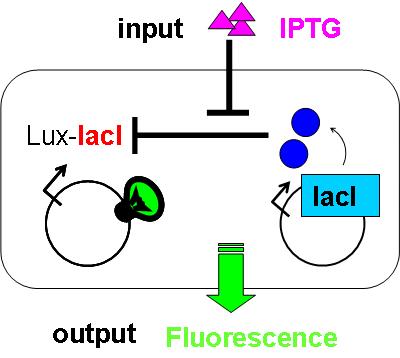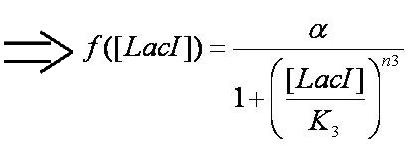Tokyo/Hill function fitting
From 2007.igem.org
| Line 35: | Line 35: | ||
Moreover, assume that [IPTG]total was more than [LacI=IPTG] predominantly, | Moreover, assume that [IPTG]total was more than [LacI=IPTG] predominantly, | ||
<br>[[Image:expression6-14.JPG|400px|none|thumb|Ex.6.9]] | <br>[[Image:expression6-14.JPG|400px|none|thumb|Ex.6.9]] | ||
| - | + | By substituting Ex.6.9 into Ex.6.8, [LacI] was obtained as | |
| - | + | <br>[[Image:expression6-15.JPG|400px|none|thumb|Ex.6.10]] | |
Revision as of 07:10, 25 October 2007
Works top 0.Hybrid promoter 1.Formulation 2.Assay1 3.Simulation 4.Assay2 5.Future works
Purpose of this assay 1.AHL assay 2.IPTG assay Preliminary assays
<ヒル関数の導出>
Deviation of Hill function
1.Hill function for the activator AHL
Without the repression by LacI( [LacI]=0 ), Ex.6.1 was described as
Therefore, in the steady state the Hill function for the activator AHL was given as
2.Hill function for the repressor LacI
When the concentration of AHL was assumed to be infinity, Ex.6.1 was described as
Therefore, in the steady state the Hill function for the repressor LacI was given as
However, the amount of LacI cannot be actually measured.So,we used the inducer IPTG to calculate the Hill function for LacI.
Assume that the reaction between [LacI] and [IPTG] is the equilibrium reaction,these concentration in equilibrium state were shown in Fig.3.
Therefore,the equilibrium constant k0 was obtained as
Moreover, assume that [IPTG]total was more than [LacI=IPTG] predominantly,
By substituting Ex.6.9 into Ex.6.8, [LacI] was obtained as













